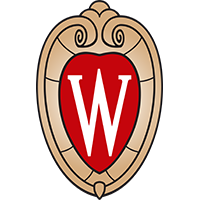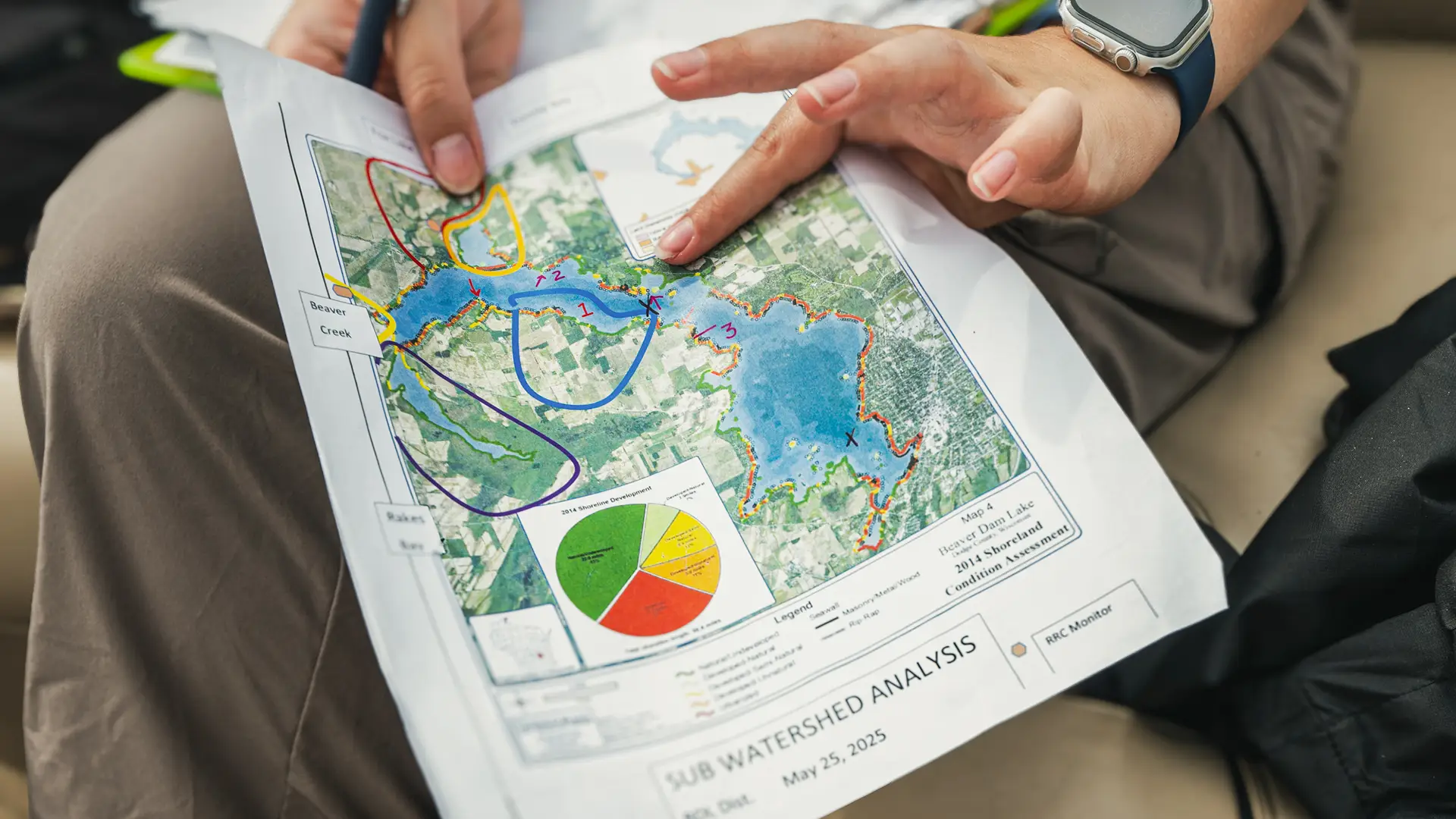Grab your lifejackets and sunscreen — it’s boating season! But instead of coolers and fishing poles, the water resources management (WRM) cohort brought along turbidimeters, Secchi disks, and plenty of scientific curiosity.
On Beaver Dam Lake, seven WRM students spent the day working with local partners on their practicum project. From early morning water sampling to afternoon shoreline surveys, the cohort rolled up their sleeves to collect data, explore solutions to improve lake health, and build recommendations that will benefit both the ecosystem and the community.
Transcript
Transcript may be edited for clarity or brevity.
Naz Nazri: Hi, my name is Naz. I am from Kuala Lumpar, Malaysia. It’s a long ways, but I’m happy to be here. We are currently conducting field work on this beautiful lake right now. Beaver Dam Lake. It’s been a really enriching experience to be out there in the field to work with your hands and to engage the community towards the betterment of this lake. The mission is to — we have a bigger community engagement component. We’re going out to events. We are sending out flyers through mail surveys. In order to really get an idea of what people want from this lake. We’re hoping that together we can form the foundations where their kids can carry on that desire to care for a lake essentially.
For their practicum, seven WRM students are partnering with the Beaver Dam Lake District (BDLA) and the Beaver Dam Lake Improvement Association (BDLIA) to improve the health and quality of Beaver Dam Lake.
On this particular field day, students have split into groups to perform water quality testing and shoreline surveys.
Sampling
Katie Bollini: There was a little bit of ghost stories happening last night.
Emily Kilstrom: Yeah, after Katie went to bed, actually, we were talking about aliens for like an hour and a half.
Katie Bollini: Which aliens are one of my favorite conversation topics, so that’s kind of rude.
Emily Kilstrom: Well, you weren’t even asleep. You could’ve come back out.
Katie Bollini: I was kind of asleep.
Emily Kilstrom: There’s a lot of interest in improving the quality of this lake. Every stakeholder that we’ve met has been very motivated and knowledgeable so it’s been a real joy to work with everybody.
Katie Bollini: The WRM group in 2017 also worked on this lake and came up with a management report so we kind of built off of that.
Emily Kilstrom: They also did a lot more work in the upland streams, too. We’re focused entirely on the lake and they did a lot of stuff on the inlets, so our projects are different but similar, and it definitely was good to have that base of information.
Right now I’m calibrating our probe, so this is going to tell us the temperature, pH, conductivity, and the dissolved oxygen of the water all the way down the water column. I’m going to take the Secchi disk now, which is just how far into the water we can see. So, it’s like the depth at which light penetrates, and you use this disk.
Shout out to Karen Huber, president of the Beaver Dam Lake Association, who has been a key contact for the WRM cohort and helped ferry the students around on her pontoon!
Katie Bollini: Yeah, that sounds kind of crazy, too. Conductivity?
Emily Kilstrom: 444.
Katie Bollini: OK, water color.
Emily Kilstrom: Green.
Katie Bollini: Column. Clear or murky?
Emily Kilstrom: Murky.
Emily Kilstrom: Oh, my gosh, you guys, guess what the pH is?
Naz Nazri: 8.5?
Emily Kilstrom: It’s 9.43.
After a morning of water sampling, the first group returned to Karen Huber’s garage to process samples and record observations.
Home Base
Naz Nazri: I’m excited to meet people at WRM@60 and to talk about their experiences while they share stories. You know, being able to draw on the wealth of experience of what they’ve done how it informs us has been really, really helpful. And we’re kind of honored to be in that position, really.
And we’re hoping that we will pass our torch to future WRM cohorts.
Filtering
This project is funded through a DNR surface water grant which is also supporting several other projects in the area.
Emily Kilstrom: Man, I can’t believe how fast that goes through.
Eamon Peterson: I don’t need to triple up, right?
Emily Kilstrom: Yeah, go around like three times and then that’ll be good. That’s perfect.
Emily Kilstrom: We keep these in tinfoil, in the fridge so that there’s no further algae development.
As the first group finished up filtering their water samples, the second group got ready to head out on their afternoon shoreline survey.
Shoreline Survey
Lexi Guzman: OK, so right now we’re doing a shoreline assessment and so we go through our DNR-approved list of items that they feel are relevant for shoreline activities. And so we have riparian buffer zone, human structures, run-off concerns, bank zone, littoral zone, and aquatic plants. And then we’ve also added a coarse woody habitat section so that’s just if there are large logs in the water that it can create good habitat for fish and other things like that. So, we’ll just go through that list, call them all out, and then Carly will be recording that all in our shoreline app that we made through GIS.
When visiting Beaver Dam, students camp at Derge Park — the perfect bonding experience with campfires, s’mores, and ghost stories!
Lexi Guzman: I would say herbaceous cover, but maybe not shrubs.
Carly Winner: He is not the wetland, basically.
Lexi Guzman: He doesn’t have any of the wetland?
Carly Winner: He has some actually.
Lexi Guzman: OK.
Carly Winner: It’s that line of trees that’s his.
Lexi Guzman: Yes, OK.
Carly Winner: It starts here. This 23220, and it goes all the way around to this one. But this, it like works really well. So, you can start here and then you make like you can do the same exact thing you can add points and go around.
The students will present their findings and management recommendations to the Beaver Dam Lake District and Beaver Dam Lake Improvement Association by December 2025 with a comprehensive draft report to be completed by spring 2026.
Naz Nazri: It is a very different experience to be part of a cohort that’s pretty tight and you learn to truly work together as a team towards the betterment of an environmental mission. You learn so much, and there’s always diversity of opinions, diversity of people. I am just lucky to come from so far and to be welcomed to a community of scholars, practitioners, and environmentalists. People who look forward to doing a master’s degree, they should look forward to doing a master’s degree with WRM.
Field Notes
Special thanks to the WRM students for sharing their field day and to Karen Huber for her navigation services.



